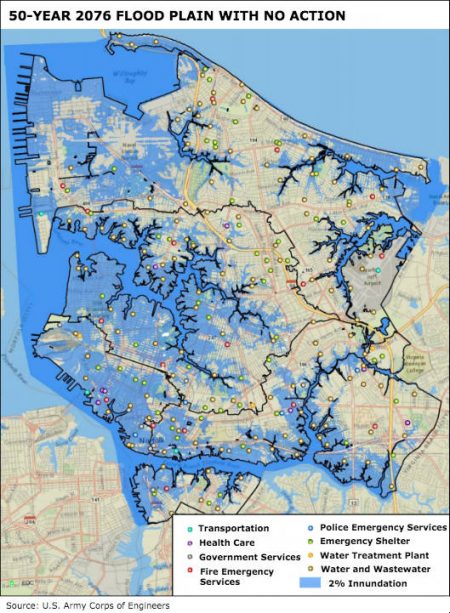November 6, 2017 – The nations of the world have gathered in Bonn starting today to continue to work on what was agreed to in Paris two years ago. COP23, however, has in attendance an American delegation denying human-caused climate change, less than a week after the issuing of its own Fourth National Climate Assessment which states “human activities, especially emission of greenhouse gases, are the dominant cause of the observed warming since the mid-20th century.” It appears no one representing the federal government’s position has read this federal government report.
At the same time, We Are Still In, a U.S. delegation representing 40 organizations, 2,580 mayors, governors, CEOs from some of America’s largest companies, and numerous colleges and universities, have also at Bonn, to show support for the previous American administration’s commitment to greenhouse gas reductions and the pledges made at COP21.
And then there is the Army Corps of Engineers, who have released in the last week, a study on the future of Norfolk and provided a draft plan to save its 1.7 million residents and the U.S. Naval Station from becoming among the first American climate change refugees.
Talk about mixed messages. It is difficult to figure out who speaks for the American people these days.
The U.S. Military Gets It
The question of Norfolk and its future survival is one that should have immediacy for the American government. The U.S. military has made it known to the government and the rest of the world that climate change is a serious security risk. That includes the risk to the Navy’s coastal military infrastructure.
Norfolk and the Hampton Roads area of Virginia, in the most recent study which forecasts sea level rises through to 2076, lies in an area of continental subsidence as The Chesapeake Bay continues to sink while the Atlantic Ocean sees an unprecedented sea level rise. The combination represents the Achilles Heel for the U.S. Navy on the Atlantic seaboard.
In its initial request for funding, The Army Corps asked for $1.8 billion to ring Norfolk with floodwalls, tidal gates, and storm surge barriers (see map below) to deal with what has been forecast as much as a 45 centimeter (1.5 foot) rise in sea levels before the end of the century. The major focus of the investment is not on the Norfolk Naval Station, but the city itself. The Naval Station, which sits at the northern end of the city, is on land that is pancake flat and barely above sea level. It already is experiencing high tide flooding. That is expected to get much worse and more frequent. Just how much more? Scientists and engineers forecast that in the next 20 to 50 year period the base will be flooded as much as 280 times annually and will spend 10% of its time under water. That means all infrastructure will be at risk.

In January of this year, the Navy issued a climate change installation adaptation and resilience handbook in which it describes the anthropogenic causes of climate change, its impact, and the necessary mitigation and adaptation strategies and methodologies recommended to deal with what is described as an imminent threat. The focus is on built and natural infrastructure and how to combat sea level rise and increasingly intense weather events.
Trump Administration Promotes Fossil Fuels at COP23
In what can only be described as hopelessly contrarian, the federal government of the United States is bringing its message of promoting coal, natural gas, and nuclear energy to Bonn, Germany, as the country’s contribution to lowering greenhouse gas emissions. The planned U.S. presentation is entitled, “The Role of Cleaner and More Efficient Fossil Fuels and Nuclear Power in Climate Mitigation,” and the presenters include representatives from the U.S. coal, nuclear and liquefied natural gas industries. This show and tell should be received poorly by most Bonn attendees. States Brian Schatz, a Senator from the State of Hawaii, “After forfeiting international leadership on climate, the Trump White House is compounding their error with a silly stunt. Fossil fuel companies are not clean energy companies, and no amount of spin will change that.”

Can “We Are Still In” Win the Hearts and Minds of Most Americans?
The growing number of U.S. cities, states, businesses, organizations, think tanks, universities, and colleges opposed to the federal government’s position on climate change hope to provide a different message to the countries gathered in Bonn.
In a separate pavilion “We Are Still In” intends to showcase American initiatives to combat climate change through reductions in greenhouse gas emissions. State governors, mayors, city councilors, businesses, investors, and educators are planning to attend throughout COP23. Governors of the U.S. Climate Alliance including Oregon’s Kate Brown and Washington’s Jay Inslee are participating. A Day of Action is planned in a dozen American cities on November 14th in support of the objectives of COP23.
“We Are Still In” represents $6.2 trillion of the U.S. economy, 9 states, 252 cities and counties, 1,780 businesses and investors, 330 colleges and universities, 213 communities of faith, and 130 million Americans, 40% of the country’s total population. Republican Mayor, James Brainard, in Carmel, Indiana, is one of many municipal members. He describes the issue of climate change as non-partisan stating, “I represent a city that is 80 percent Republican but yet we had a unanimous vote of our city council, all Republicans, a few weeks ago to set a carbon neutral goal for 2050.”
Even without Washington states Michael Bloomberg, UN Special Envoy for Cities and Climate Change, and former New York mayor, states about the U.S., “we can fulfill our Paris commitments even without help from Washington.”















